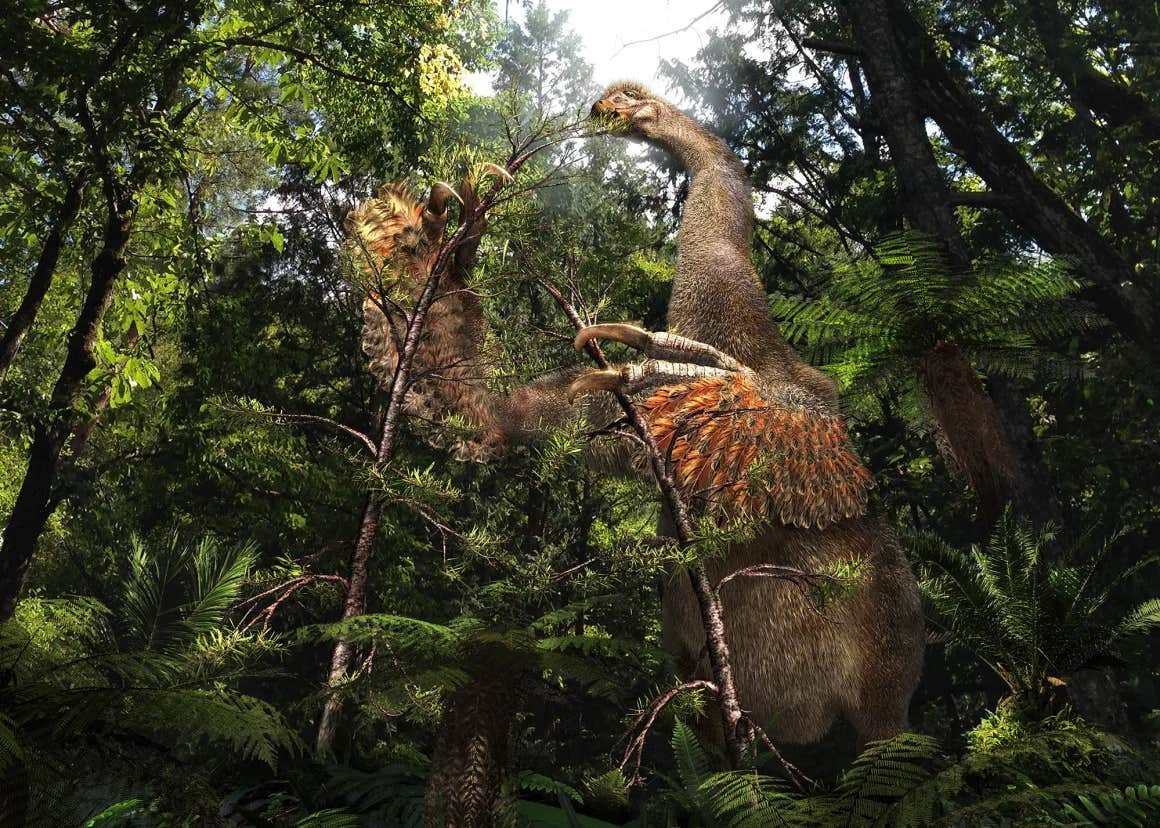Archeologists unearth the largest fully preserved dinosaur claw
New species of two-fingered dinosaur with foot-long claws found in Mongolia reveals unusual feeding and defense traits.

A strange dinosaur with two massive claws and a feathered body reshapes what scientists know about how dinosaurs fed and fought. (CREDIT: Masato Hattori)
Even among the strangest-looking dinosaurs, few are as odd as the newly discovered Duonychus tsogtbaatari. Unearthed in Mongolia’s Gobi Desert, this bizarre creature didn’t just defy expectations—it helped rewrite what scientists thought they knew about dinosaur hands. While most of its relatives had three claws, this plant-eating dinosaur evolved to walk the Earth with only two.
With its 30-centimeter-long claws and hulking frame, this species looked like something out of a dream—or a movie. “They call them the sloths of the Cretaceous period. Totally bizarre looking things,” said Darla Zelenitsky, a paleontologist at the University of Calgary and coauthor of the study describing the find.
This dinosaur didn’t just have unusual hands. It likely used those massive claws for more than just feeding. From grasping tree branches to self-defense, its limbs were key to its survival in the late Cretaceous.
Unearthing a Unique Dinosaur
The fossil was discovered in 2012, almost by accident, during the construction of a water pipeline. The pipeline cut through a rich fossil site in Mongolia’s Bayanshiree Formation, exposing bones from what turned out to be a one-of-a-kind dinosaur. Staff from the Mongolian Academy of Sciences acted fast to recover the remains.
Duonychus, meaning “two claws” in Greek, is an important addition to a rare group of herbivorous theropods called therizinosaurs. These dinosaurs are best known for their enormous claws and strange body shape: long neck, small head, heavy belly, and large arms. Most had three fingers on each hand with large curved claws used to rake plants toward their mouths.
What sets Duonychus tsogtbaatari apart is its two-fingered hands—something almost never seen in therizinosaurs or even most theropods. This evolutionary oddity sheds light on how hand structures changed over time within this clade.
Related Stories
“It evolved to just have two fingers and two claws,” said Zelenitsky. “The claws on this one are about a foot long… 30 centimeters long. We know that because one of the claws is fully preserved.”
The preservation of one of these claws is what makes the find truly extraordinary.
A Claw Like No Other
Keratin—the same substance found in human fingernails and animal hooves—rarely fossilizes. That’s what makes this discovery so significant. For the first time, researchers recovered a nearly complete keratin sheath over the claw of the left finger, showing the true size and shape of the weapon-like digit.
At about 12 centimeters long, the preserved keratin sheath reveals that the claw was much longer and sharper in life than the bone suggests. “This is by far the biggest claw preserved for a dinosaur that has that keratinous sheath on it,” Zelenitsky said.
The strong curve and high flexion of the claw point to a powerful grasp. These weren’t just display features. They were likely used to pull in branches, dig in soil, or fend off predators.
“This one is unique in having only two fingers on each of its giant arms,” said paleontologist Steve Brusatte, who was not involved in the study. “They really do look like oversized tongs you might use when barbequing.”
What Made Duonychus So Strange?
Most therizinosaurs had three fingers, a trait inherited from their early theropod ancestors. Those hands were likely used for feeding, much like a sloth uses its claws today. In fact, some scientists compare these dinosaurs to giant prehistoric sloths. Their claws would hook and pull plants toward their beaked mouths, which were filled with small, leaf-shaped teeth.
Earlier species like Falcarius and Beipiaosaurus had smaller claws, but more evolved therizinosaurs like Therizinosaurus developed massive ones. Yet none had lost a finger—until Duonychus.
The evolution of this two-fingered form might be linked to feeding habits. “It may have specialized in a certain way,” Zelenitsky said. “Maybe it was a certain kind of plant type or had a certain feeding behavior so it made sense to reduce the number of fingers on the hand.”
The dinosaur was not small. It stood about 3 meters tall and weighed around 260 kilograms. Its long neck may have helped it reach high branches, while its claws could handle limbs as thick as 10 centimeters in diameter.
Behavior, Defense, and a Feathered Coat
Duonychus was not a predator, but its claws weren’t just for show. “They would have made formidable weapons … these claws,” Zelenitsky noted. Sharp, large, and curved, the claws would have made this plant-eater difficult prey. They could slice or jab if threatened.
The team also found parts of its spine, hips, tail, arms, and legs, which helped build a clearer picture of its appearance. With its pot-bellied frame, long arms, and sharp claws, it resembled a hybrid of sloth, giraffe, and a horror movie icon. No wonder Brusatte compared it to Edward Scissorhands.
But unlike that fictional character, this dinosaur may have had feathers. Zelenitsky pointed out that many therizinosaurs had feathered bodies. “They were covered in feathers,” she said, “adding to their odd-looking demeanor.”
The find’s uniqueness lies not just in anatomy, but also in preservation. David Hone, a paleontologist at Queen Mary University of London, said, “I’ve seen fragments from other specimens from the Gobi, but never a whole sheath like this. The kind of preservation here… doesn’t usually preserve keratin.”
That keratin is key to understanding how dinosaurs lived. Since keratin is softer than bone, it changes how claws interact with the world. Without it, scientists can only guess at a claw’s true function.
Rewriting the Rulebook on Dinosaur Hands
Therizinosaurs have always puzzled paleontologists. As plant-eating theropods, they blur the line between predators and grazers. Their long necks, unusual teeth, and powerful arms point to a group that adapted in surprising ways.
Though rare, therizinosaur hand fossils have been found before. In species like Jianchangosaurus and Nothronychus, three-fingered hands held large, hooked claws thought to grasp food. In these species, claws grew larger over time, likely to improve their feeding ability. But they always kept three fingers—until now.
The discovery of Duonychus tsogtbaatari adds a new twist to the story. This is the first known therizinosaur with only two functional digits, possibly pointing to a new way of life. Though speculative, it may have evolved to favor strength over flexibility, trading extra fingers for stronger grip.
“We know that fewer fingers can sometimes mean specialization,” said Zelenitsky. “It’s similar to how some modern animals have reduced digits for digging or grasping.”
Only a few dinosaur groups had two fingers. The most famous is Tyrannosaurus rex, which had tiny, almost useless arms. In contrast, Duonychus used its arms and claws as active tools in its daily life.
Today, about 50 new dinosaur species are discovered every year. Most fade into the fossil record with little notice. But this one, with its preserved claw sheath and evolutionary twist, stands out.
“This is yet another example of a wonderful new dinosaur that we couldn’t have dreamed ever existed if we didn’t find its fossils,” said Brusatte.
Note: The article above provided above by The Brighter Side of News.
Like these kind of feel good stories? Get The Brighter Side of News' newsletter.
Rebecca Shavit
Science & Technology Journalist | Innovation Storyteller
Based in Los Angeles, Rebecca Shavit is a dedicated science and technology journalist who writes for The Brighter Side of News, an online publication committed to highlighting positive and transformative stories from around the world. With a passion for uncovering groundbreaking discoveries and innovations, she brings to light the scientific advancements shaping a better future. Her reporting spans a wide range of topics, from cutting-edge medical breakthroughs and artificial intelligence to green technology and space exploration. With a keen ability to translate complex concepts into engaging and accessible stories, she makes science and innovation relatable to a broad audience.



